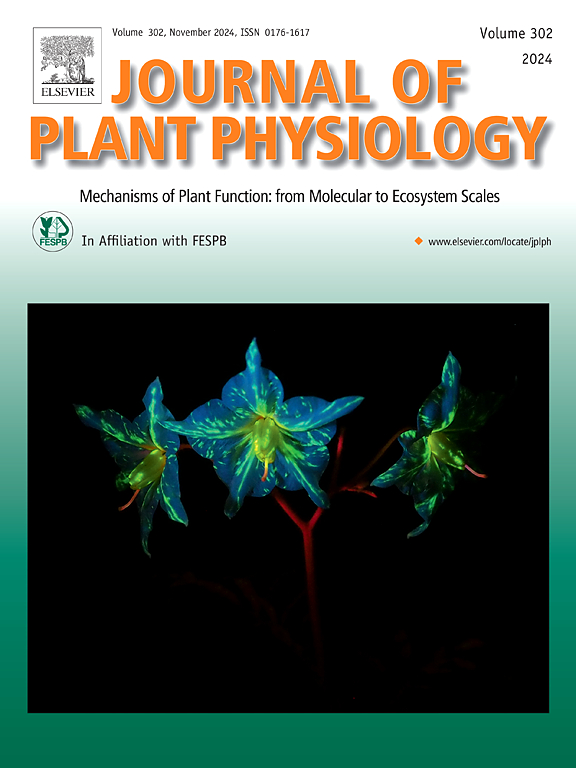对ja敏感的SNAC1-ASMT1调控模块促进大麦褪黑激素介导的盐胁迫耐受的证据
IF 4.1
3区 生物学
Q1 PLANT SCIENCES
引用次数: 0
摘要
褪黑素已成为植物对非生物胁迫反应的重要媒介,其调节作用密切依赖于其内源水平和生物合成动力学。然而,在大麦(Hordeum vulgare L.)中,盐度胁迫下褪黑素生物合成的上游调控机制及其与激素信号的联系在很大程度上仍然未知。在这项研究中,我们探索了大麦中褪黑激素关键生物合成基因乙酰5 -羟色胺o -甲基转移酶1 (ASMT1)的潜在调控模块。启动子分析在ASMT1启动子区域发现了假定的应力响应型NAC1 (SNAC1)结合基序,转录组学数据显示SNAC1和ASMT1在盐度暴露下的差异表达。为了进一步研究这种调节关系,我们在温室进行了6个对照试验:对照、茉莉酸(JA)、DIECA(一种JA生物合成抑制剂)、盐度(S)、JA + S和DIECA + S。外源JA显著增加了SNAC1和ASMT1的表达,提高了褪黑激素水平,激活了抗氧化酶(SOD、CAT、APX),减少了盐胁迫下的氧化损伤和光合作用下降。相反,DIECA抑制JA生物合成会减弱这些反应,支持JA信号通路的参与。此外,我们观察到基因表达谱和褪黑激素含量之间具有统计学意义的相关性。虽然需要进一步的功能验证,但我们的研究结果支持了一个模型,即JA信号可能通过SNAC1-ASMT1轴参与盐分诱导的褪黑激素生物合成。这些发现为了解应激过程中激素如何调节褪黑激素提供了新的见解,并为未来旨在提高大麦耐受性的功能研究提供了框架。本文章由计算机程序翻译,如有差异,请以英文原文为准。
Evidence for a JA-responsive SNAC1–ASMT1 regulatory module contributing to melatonin-mediated salinity stress tolerance in Barley
Melatonin has emerged as a crucial mediator in plant responses to abiotic stresses, with its regulatory effects closely dependent on its endogenous levels and biosynthetic dynamics. However, in barley (Hordeum vulgare L.), the upstream regulatory mechanisms of melatonin biosynthesis under salinity stress, and their connection to hormonal signaling, remain largely unknown. In this study, we explore the potential regulatory modules of the key melatonin biosynthesis gene, Acetylserotonin O-Methyltransferase 1 (ASMT1), in barley. Promoter analysis identified putative Stress-responsive NAC1 (SNAC1) binding motifs within the ASMT1 promoter region, and transcriptomic data showed the differential expression of SNAC1 and ASMT1 in response to salinity exposure. To further investigate this regulatory relationship, we performed a controlled greenhouse experiment with six treatments: control, Jasmonic acid (JA), DIECA (a JA biosynthesis inhibitor), salinity (S), JA + S, and DIECA + S. Exogenous JA significantly increased SNAC1 and ASMT1 expression, boosted melatonin levels, activated antioxidant enzymes (SOD, CAT, APX), and reduced oxidative damage and photosynthetic decline under salinity. In contrast, inhibition of JA biosynthesis by DIECA attenuated these responses, supporting the involvement of JA signaling in this pathway. Additionally, we observed a statistically significant correlation between gene expression profiles and melatonin content. While further functional validation is needed, our results support a model in which JA signaling contributes to salinity-induced melatonin biosynthesis, possibly through the SNAC1–ASMT1 axis. These findings offer new insights into how hormones regulate melatonin during stress and provide a framework for future functional studies aimed at improving stress tolerance in barley.
求助全文
通过发布文献求助,成功后即可免费获取论文全文。
去求助
来源期刊

Journal of plant physiology
生物-植物科学
CiteScore
7.20
自引率
4.70%
发文量
196
审稿时长
32 days
期刊介绍:
The Journal of Plant Physiology is a broad-spectrum journal that welcomes high-quality submissions in all major areas of plant physiology, including plant biochemistry, functional biotechnology, computational and synthetic plant biology, growth and development, photosynthesis and respiration, transport and translocation, plant-microbe interactions, biotic and abiotic stress. Studies are welcome at all levels of integration ranging from molecules and cells to organisms and their environments and are expected to use state-of-the-art methodologies. Pure gene expression studies are not within the focus of our journal. To be considered for publication, papers must significantly contribute to the mechanistic understanding of physiological processes, and not be merely descriptive, or confirmatory of previous results. We encourage the submission of papers that explore the physiology of non-model as well as accepted model species and those that bridge basic and applied research. For instance, studies on agricultural plants that show new physiological mechanisms to improve agricultural efficiency are welcome. Studies performed under uncontrolled situations (e.g. field conditions) not providing mechanistic insight will not be considered for publication.
The Journal of Plant Physiology publishes several types of articles: Original Research Articles, Reviews, Perspectives Articles, and Short Communications. Reviews and Perspectives will be solicited by the Editors; unsolicited reviews are also welcome but only from authors with a strong track record in the field of the review. Original research papers comprise the majority of published contributions.
 求助内容:
求助内容: 应助结果提醒方式:
应助结果提醒方式:


